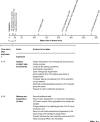Clinical review: the Israeli experience: conventional terrorism and critical care
- PMID: 16277738
- PMCID: PMC1297605
- DOI: 10.1186/cc3762
Clinical review: the Israeli experience: conventional terrorism and critical care
Abstract
Over the past four years there have been 93 multiple-casualty terrorist attacks in Israel, 33 of them in Jerusalem. The Hadassah-Hebrew University Medical Center is the only Level I trauma center in Jerusalem and has therefore gained important experience in caring for critically injured patients. To do so we have developed a highly flexible operational system for managing the general intensive care unit (GICU). The focus of this review will be on the organizational steps needed to provide operational flexibility, emphasizing the importance of forward deployment of intensive care unit personnel to the trauma bay and emergency room and the existence of a chain of command to limit chaos. A retrospective review of the hospital's response to multiple-casualty terror incidents occurring between 1 October 2000 and 1 September 2004 was performed. Information was assembled from the medical center's trauma registry and from GICU patient admission and discharge records. Patients are described with regard to the severity and type of injury. The organizational work within intensive care is described. Finally, specific issues related to the diagnosis and management of lung, brain, orthopedic and abdominal injuries, caused by bomb blast events associated with shrapnel, are described. This review emphasizes the importance of a multidisciplinary team approach in caring for these patients.
Figures
References
-
- Kluger Y. Bomb explosions in acts of terrorism: detonation, wound ballistics, triage and medical concerns. Isr Med Assoc J. 2003;5:235–240. - PubMed
-
- Leibovici D, Gofrit ON, Stein M, Shapira SC, Noga Y, Heruti RJ, Shemer J. Blast injuries: bus versus open-air bombings – a comparative study of injuries in survivors of open-air versus confined-space explosions. J Trauma. 1996;41:1030–1035. - PubMed
Publication types
MeSH terms
LinkOut - more resources
Full Text Sources
Medical
Research Materials
Miscellaneous


